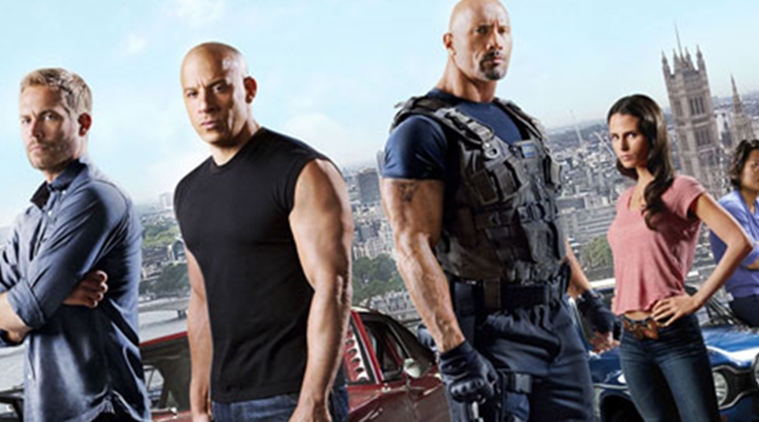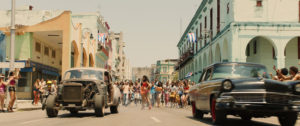F. Gary Gray narrates a sequence from his film featuring Vin Diesel and Celestino Cornielle. Yes, the makers of the “Fast and the Furious” franchise have staged countless car races throughout the years. But the one that opens the latest film, “The Fate of the Furious,” is more historic than the others.
It’s the first Hollywood movie sequence shot in Cuba since the United States economic embargo was imposed more than 50 years ago. And the scene is as complicated as any other from the franchise. It features Dom Toretto (Vin Diesel) in a rusted-out 1950 Chevrolet Fleetline, and his competitor Raldo (Celestino Cornielle) in a 1956 Ford Fairlane, weaving their way through the streets of Havana.
“You’ve never been to Cuba in the way that we take you to Cuba,” said the film’s director, F. Gary Gray. In an interview in New York, he discussed how he won approval to shoot there, what it took to bring in an American helicopter for aerial shots and the process of making a Hollywood movie in a country with limited resources.
According with him “I had to give, in advance, details of every shot, every angle and every road we were going to shoot on. But they were very nice. We were in and out of Cuba quite a bit during preproduction, and you could see the improvements happening in between. One month, a location would look a certain way, and we would come back the next month, and the roads would be paved”. And continue “We had a hard time sending and receiving emails. Cell Phone service, calls back and forth to the States, were extremely challenging. Some of the simplest things, we needed a team of scientists to figure out. But I would say what you lose in convenience, you gain in heart and aesthetics”.
“We brought in our helicopter with this huge camera on it. It looks like a spaceship to the locals and is flying 50 feet above our heads at top speed, chasing the two cars driving through the streets. I set up this big screen for the locals to see what the helicopter was shooting. We’re sending the video signal back to this monitor, and they’re watching their city from the sky. A lot of them have never been on a plane. You start seeing tears stream. Then we start to cry, because they’re crying, and it’s this moment you share where you realize how special it is and how much we take for granted” he finished.
Anatomía de “The Fate of the Furious” (El Destino de los Furiosos) filmada en Cuba. Vídeo.
F. Gary Gray narra una secuencia de su película con Vin Diesel y Celestino Cornielle. Sí, los fabricantes de la franquicia “Fast and the Furious” han organizado innumerables carreras de autos a lo largo de los años. Pero el que abre la última película, “El Destino de los Furiosos”, es más histórico que los demás.
Es la primera secuencia cinematográfica de Hollywood filmada en Cuba desde que el embargo económico de Estados Unidos fue impuesto hace más de 50 años. Y la escena es tan complicada como cualquier otra de la franquicia. Cuenta con Dom Toretto (Vin Diesel) en un Chevrolet Fleetline de 1950, y su competidor Raldo (Celestino Cornielle) en un Ford Fairlane de 1956, abriéndose paso por las calles de La Habana.
https://youtu.be/t83YU-vOwak
“Nunca has estado en Cuba como lo llevamos a Cuba”, dijo el director de la película, F. Gary Gray. En una entrevista en Nueva York, habló de cómo obtuvo la aprobación para rodar allí, lo que tomó para traer un helicóptero estadounidense para disparos aéreos y el proceso de hacer una película de Hollywood en un país con recursos limitados.
Según el “tuve que dar, por adelantado, los detalles de cada disparo, cada ángulo y cada camino que íbamos a rodar, pero eran muy agradables. Estuvimos dentro y fuera de Cuba bastante durante la preproducción y Se podían ver las mejoras que se producen en el medio. Un mes, una ubicación se vería de cierta manera, y volveríamos el próximo mes, y las carreteras serían pavimentadas”. Y continúa “Tuvimos dificultades para enviar y recibir correos electrónicos, el servicio de telefonía celular, llamadas de ida y vuelta a los Estados Unidos, eran extremadamente desafiantes, algunas de las cosas más sencillas, necesitábamos un equipo de científicos para averiguar. Perder en comodidad, se gana en el corazón y la estética”.
“Trajimos nuestro helicóptero con esta enorme cámara. Parecía una nave espacial para los lugareños y que está volando 50 pies sobre nuestras cabezas a toda velocidad, persiguiendo a los dos coches de conducción a través de las calles. Establecí una gran pantalla para que los lugareños vieran lo que el helicóptero estaba disparando. Estamos enviando la señal de video de vuelta a este monitor, y están viendo su ciudad desde el cielo. Muchos de ellos nunca han estado en un avión. Empiezas a ver la corriente de lágrimas. Entonces empezamos a llorar, porque están llorando, y es este momento que compartes donde te das cuenta de lo especial que es y lo que damos por sentado”, terminó diciendo.
Agencias / TheNewYorkTimes / Mekado Murphy / Internet Photos/ YouTube / Arnoldo Varona / TheCubanHistory.com
THE CUBAN HISTORY, HOLLYWOOD.








